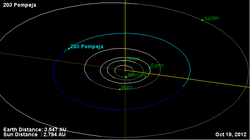Astronomy:203 Pompeja
 Orbital diagram | |
| Discovery | |
|---|---|
| Discovered by | C. H. F. Peters |
| Discovery date | 25 September 1879 |
| Designations | |
| (203) Pompeja | |
| Pronunciation | /pɒmˈpiːə/[1] |
| Named after | Pompeii |
| A879 SA, 1895 EA | |
| Minor planet category | Main belt |
| Orbital characteristics[2] | |
| Epoch 31 July 2016 (JD 2457600.5) | |
| Uncertainty parameter 0 | |
| Observation arc | 136.43 yr (49,832 d) |
| |{{{apsis}}}|helion}} | 2.897 astronomical unit|AU (433.4 Gm) |
| |{{{apsis}}}|helion}} | 2.577 AU (385.5 Gm) |
| 2.737 AU (409.4 Gm) | |
| Eccentricity | 0.058490 |
| Orbital period | 4.53 yr (1,653.6 d) |
| Average Orbital speed | 18.01 km/s |
| Mean anomaly | 47.6383° |
| Mean motion | 0° 13m 3.72s / day |
| Inclination | 3.1780° |
| Longitude of ascending node | 347.916° |
| 57.060° | |
| Physical characteristics | |
| Dimensions | 116.25±2.5 km |
| Rotation period | 24.052 h (1.0022 d)[3][2] |
| Geometric albedo | 0.0410±0.002 |
| DCX: | |
| Absolute magnitude (H) | 8.76 |
Pompeja (minor planet designation: 203 Pompeja) is a quite large main-belt asteroid. It was discovered by C. H. F. Peters on September 25, 1879, in Clinton, New York, and named after Pompeii, the Roman town destroyed in volcanic eruption in AD 79. This asteroid is orbiting the Sun at a distance of 2.74 astronomical unit|AU with an eccentricity (ovalness) of 0.06 and a period of 4.53 yr. The orbital plane is tilted at an angle of 3.2° to the plane of the ecliptic.[2]
Based upon photometric observations taken during 2011, it has a synodic rotation period of 24.052 ± 0.001 h, with a peak-to-peak amplitude of 0.10 ± 0.01 in magnitude. Because the rotation period nearly matches that of the Earth, it required coordinated observations from multiple observatories at widely spaced latitudes to produce a complete light curve.[3] As discovered in 2021, the asteroid has a very red color due to tholins on its surface, similar to trans-Neptunian objects. It is therefore thought to have formed in the outer Solar System despite its current orbit within the asteroid belt.[4]
References
- ↑ 'Pompeia' in Noah Webster (1884) A Practical Dictionary of the English Language
- ↑ 2.0 2.1 2.2 "203 Pompeja". JPL Small-Body Database. NASA/Jet Propulsion Laboratory. https://ssd.jpl.nasa.gov/sbdb.cgi?sstr=203;cad=1.
- ↑ 3.0 3.1 Pilcher, Frederick et al. (July 2012), "Rotation Period Determination for 203 Pompeja - Another Triumph of Global Collaboration", The Minor Planet Bulletin 39 (3): 99, Bibcode: 2012MPBu...39...99P
- ↑ Hasegawa, Sunao; Marsset, Michaël; Demeo, Francesca E.; Bus, Schelte J.; Geem, Jooyeon; Ishiguro, Masateru; Im, Myungshin; Kuroda, Daisuke et al. (2021), "Discovery of two TNO-like bodies in the asteroid belt", The Astrophysical Journal Letters 916 (1): L6, doi:10.3847/2041-8213/ac0f05, Bibcode: 2021ApJ...916L...6H
External links
- The Asteroid Orbital Elements Database
- Minor Planet Discovery Circumstances
- Asteroid Lightcurve Parameters
- Asteroid Albedo Compilation
- 203 Pompeja at AstDyS-2, Asteroids—Dynamic Site
- 203 Pompeja at the JPL Small-Body Database
 |

